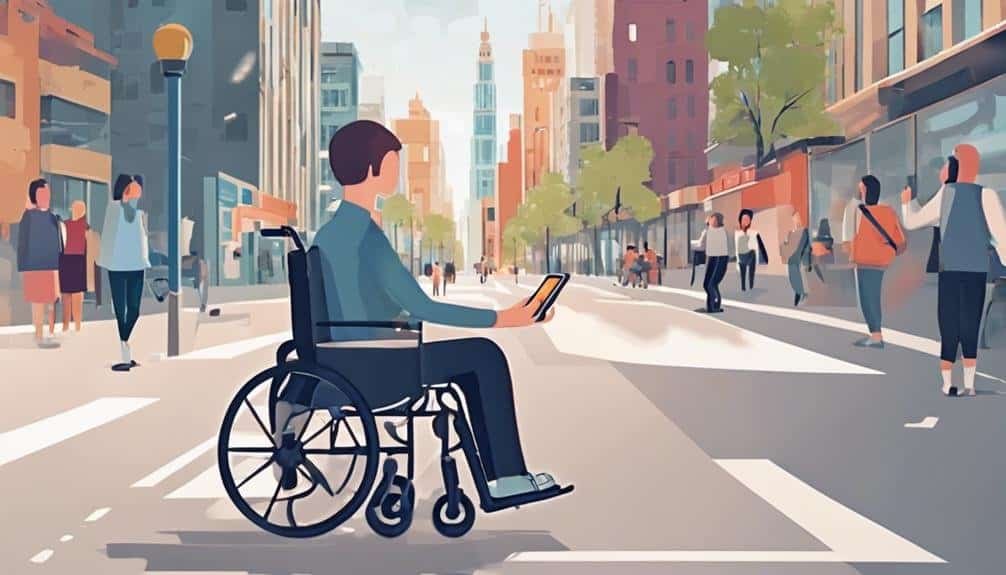AI in Enhancing Accessibility for Disabled Individuals: A Practical Guide
Imagine a world where technology becomes the bridge to inclusivity rather than a barrier – this is the essence of AI in enhancing accessibility for disabled individuals.
As you navigate the complex landscape of artificial intelligence and its practical applications, understanding how these advancements can empower and support individuals with disabilities is crucial.
From speech recognition technologies to AI-powered mobility solutions, the possibilities are vast and transformative.
Join us as we explore the tangible ways AI is revolutionizing accessibility, paving the way for a more inclusive future.
Key Takeaways
- Speech recognition and visual recognition technologies empower independence and communication for disabled individuals.
- AI-powered mobility solutions offer personalized assistance and enhance navigation for people with disabilities.
- Cognitive assistance tools support engagement with educational content and aid in organizing information effectively.
- AI in communication enhancement provides accurate transcription, virtual sign language interpreters, and real-time captioning for accessibility.
Overview of AI and Accessibility
When venturing into the realm of AI and Accessibility, you’ll discover a landscape rich with innovative solutions and transformative potential. AI has the power to revolutionize accessibility for disabled individuals, but it also brings forth challenges such as AI ethics and bias. Ensuring that AI technologies are developed and implemented with ethical considerations in mind is crucial to creating inclusive solutions. Addressing biases in AI algorithms is essential to prevent discrimination and ensure fair treatment for all users.
User experience and design play a pivotal role in the success of AI-driven accessibility solutions. By prioritizing user-centered design principles, developers can create products that are intuitive, easy to use, and cater to the diverse needs of disabled individuals. Considering accessibility from the initial stages of product development is key to building inclusive AI solutions that enhance the lives of users.
Embracing AI in accessibility initiatives opens up a world of possibilities for improving the quality of life for disabled individuals. By fostering a culture of innovation and empathy, developers can harness the full potential of AI to break down barriers and create a more inclusive society. Through thoughtful design and a commitment to ethical practices, AI has the power to transform accessibility and empower individuals with disabilities.
Speech Recognition Technologies
Speech recognition technologies offer a transformative way for individuals with disabilities to interact with digital devices and access information more seamlessly. These technologies can greatly enhance accessibility and independence for individuals with speech impairments or motor disabilities.
Here are three key ways in which speech recognition technologies can make a significant impact:
- Voice Controlled Devices: Speech recognition enables individuals to control various devices using voice commands. This feature is particularly beneficial for those with mobility impairments, allowing them to operate smartphones, computers, smart home devices, and more without the need for manual input.
- Speech Therapy: Speech recognition tools can be utilized in speech therapy sessions to assist individuals in improving their communication skills. By providing real-time feedback on pronunciation and intonation, these technologies can enhance the effectiveness of therapy sessions and help individuals make progress more efficiently.
- Accessibility Features and Communication Aids: Speech recognition technology is integrated into many accessibility features and communication aids designed for individuals with disabilities. These tools enable users to dictate text, compose emails, browse the internet, and perform other tasks using their voice, making it easier for them to communicate and access information independently.
Visual Recognition Applications
Imagine a world where technology can identify objects and read text aloud to assist those with visual impairments. Visual recognition applications use object recognition technology coupled with text-to-speech functionality to provide real-time assistance for individuals with disabilities.
Object Recognition Technology
Utilizing advanced object recognition technology, individuals with disabilities can experience a more inclusive and seamless interaction with their surroundings. This technology holds immense potential in enhancing accessibility for those with visual impairments.
Here’s how it can benefit users:
- Enhanced User Experience: Object recognition applications can provide real-time audio descriptions of the environment, enabling users to navigate with greater independence.
- Overcoming Accessibility Challenges: By identifying objects and obstacles in the surroundings, this technology helps individuals with visual impairments to move around safely and confidently.
- Promoting Inclusivity: Object recognition technology fosters a more accessible environment, allowing users to engage more fully in daily activities and interactions.
Text-to-Speech Functionality
With the integration of text-to-speech functionality in visual recognition applications, a new level of accessibility and independence is unlocked for individuals with visual impairments. Voice control allows users to interact with devices effortlessly, while language translation features enable real-time understanding of text in different languages. Below is a table illustrating the key features of text-to-speech functionality in visual recognition applications:
| Feature | Description | Benefit |
|---|---|---|
| Voice Control | Enables hands-free operation | Increased accessibility for users |
| Language Translation | Translates text into different languages | Facilitates understanding of diverse content |
AI-Powered Mobility Solutions
AI-driven technologies are revolutionizing the way disabled individuals access and navigate their surroundings, particularly through innovative mobility solutions. These advancements not only enhance independence but also improve quality of life significantly.
Here’s how AI-powered mobility solutions are making a difference:
- Smart Navigation: AI enables smart navigation systems that can assist individuals in planning routes, avoiding obstacles, and providing real-time updates on accessible pathways. These technologies help in overcoming physical barriers and ensuring a smoother travel experience.
- Adaptive Technology: Through adaptive technology, AI can customize mobility solutions based on individual needs and preferences. This personalization ensures that the technology aligns perfectly with the user’s requirements, whether it’s adjusting speed, providing audio cues, or optimizing routes for specific mobility devices.
- Real-time Assistance: AI-powered mobility solutions offer real-time assistance by analyzing environmental data and making instant adjustments to the user’s travel plans. This quick response to changing conditions ensures that individuals can navigate their surroundings with confidence and minimal disruptions.
Cognitive Assistance Tools
Enhancing the accessibility and support for disabled individuals, cognitive assistance tools offer tailored solutions that cater to specific cognitive needs, complementing the advancements in AI-powered mobility solutions. These tools are designed to assist individuals in various aspects of their cognitive functioning, providing essential aid in daily tasks and activities.
Assistive learning is a key feature of cognitive assistance tools, helping individuals with disabilities access educational materials in a way that suits their learning style. These tools can adapt content, provide interactive lessons, and offer personalized feedback to enhance the learning experience. By tailoring information delivery to individual needs, assistive learning tools empower disabled individuals to engage with educational content effectively.
Memory aids are another crucial aspect of cognitive assistance tools, supporting individuals in organizing, storing, and retrieving information. These aids can range from simple reminder systems to sophisticated software that helps with task management and scheduling. By leveraging AI technology, memory aids can adapt to an individual’s specific requirements, offering customized solutions to enhance memory retention and recall.
Innovations in cognitive assistance tools continue to shape the landscape of accessibility for disabled individuals, providing valuable support in various cognitive domains. By integrating assistive learning and memory aids, these tools play a vital role in empowering individuals to overcome cognitive challenges and lead more independent and fulfilling lives.
AI in Web Accessibility
When it comes to web accessibility, AI plays a crucial role in enhancing user experiences for individuals with disabilities.
AI for screen readers enables visually impaired users to navigate websites more effectively by interpreting and vocalizing content.
Additionally, AI-powered captioning tools help deaf or hard of hearing individuals access audio content through real-time transcription.
AI for Screen Readers
By incorporating AI technology into screen readers, websites can become more accessible for individuals with visual impairments. AI enhances screen readers by providing advanced features like voice activation and language translation. Here’s how AI is transforming screen readers:
- Natural-sounding Voices: AI enables screen readers to produce more human-like voices, making the reading experience more engaging and easier to follow.
- Multi-Language Support: With AI-powered language translation, screen readers can now instantly translate content into different languages, breaking down language barriers for visually impaired users.
- Contextual Understanding: AI algorithms help screen readers interpret and convey content contextually, improving comprehension and making the web more inclusive for everyone.
AI for Captioning
Utilizing AI technology for captioning on websites can significantly enhance accessibility for individuals with hearing impairments. Real-time captioning powered by AI provides immediate text display of spoken content, ensuring that those with hearing difficulties can follow along seamlessly. Automatic transcription capabilities allow for the conversion of audio content into text, making online videos, podcasts, and webinars more inclusive and understandable. Below is a table showcasing the benefits of AI captioning:
| Benefits of AI Captioning | Description |
|---|---|
| Real-time captioning | Instantaneous text display of speech |
| Automatic transcription | Conversion of audio content into text |
Virtual Assistants for Disability Support
Virtual assistants tailored to provide disability support are revolutionizing accessibility for individuals with disabilities by offering personalized assistance and empowering independence. These AI-powered tools are designed to cater to the unique needs of people with disabilities, providing them with customized support in various aspects of their daily lives.
Key Points:
- Virtual assistants for disability navigation: Virtual assistants can assist individuals with disabilities in navigating physical spaces, such as providing detailed directions for wheelchair-accessible routes or suggesting alternative transportation options for those with mobility challenges.
- AI for personalized disability support: Through advanced AI algorithms, virtual assistants can learn and adapt to the specific requirements of each user. This personalization allows for tailored recommendations, reminders, and assistance that cater to the individual’s unique needs and preferences.
- Enhancing independence and empowerment: By leveraging virtual assistants for disability support, individuals can gain greater autonomy and confidence in managing their daily tasks and activities. These tools not only provide practical assistance but also foster a sense of self-reliance and empowerment among users.
Incorporating virtual assistants into disability support services represents a significant step towards creating a more inclusive and accessible environment for individuals with disabilities. By harnessing the capabilities of AI, these tools have the potential to greatly enhance the quality of life for people with diverse accessibility needs.
Enhancing Communication With AI
Imagine having the ability to express yourself effortlessly with AI tools like Speech-To-Text technology. This technology can transcribe your spoken words into written text with remarkable accuracy.
Additionally, Virtual Sign Language Interpreters can bridge the communication gap for individuals who are deaf or hard of hearing. This enables smoother interactions, creating more inclusive and accessible environments for individuals with disabilities.
These advancements in AI communication technologies hold immense promise.
Speech-To-Text Technology
Enhance your communication capabilities with AI through the innovative Speech-To-Text technology, transforming spoken words into written text seamlessly. This technology offers a range of benefits including:
- Voice Control: Effortlessly dictate messages or commands, making communication more accessible and efficient.
- Language Translation: Instantly convert spoken words into various languages, breaking down language barriers and fostering better understanding.
- Improved Accessibility: Enable individuals with speech impairments to communicate effectively by transcribing their spoken words into text in real-time.
Speech-To-Text technology not only enhances communication but also promotes inclusivity and independence for individuals with disabilities, revolutionizing the way we interact and connect with others.
Virtual Sign Language Interpreter
Effortlessly bridge communication barriers for individuals with hearing impairments by exploring the innovative Virtual Sign Language Interpreter, a revolutionary AI technology that enhances accessibility and inclusivity.
This cutting-edge tool utilizes gesture recognition and virtual reality to interpret and translate sign language into spoken language, breaking down communication obstacles. By accurately capturing facial expressions and using machine learning algorithms, the Virtual Sign Language Interpreter ensures precise and real-time translations, fostering seamless interactions between individuals who use sign language and those who do not.
This transformative technology empowers individuals with hearing impairments to communicate effectively in various settings, promoting inclusivity and understanding. Embrace the Virtual Sign Language Interpreter to revolutionize communication and create a more accessible world for all.
AI for Environmental Accessibility
By employing advanced AI technologies, we can revolutionize environmental accessibility for disabled individuals, paving the way for a more inclusive and equitable world. When it comes to enhancing environmental accessibility through AI, the possibilities are vast and transformative.
Here’s how AI can make a difference:
AI for Environmental Accessibility
- Smart Navigation Systems: AI-powered navigation systems can assist individuals with disabilities in maneuvering through indoor and outdoor spaces seamlessly. These systems can provide real-time information on accessible routes, elevators, ramps, and other facilities within buildings or public areas, enhancing independence and mobility.
- Personalized Assistance in Smart Homes: AI can be integrated into smart home devices to cater to the specific needs of disabled individuals. From voice-controlled assistants that adjust lighting and temperature to automated door openers and smart appliances, AI can create a more accessible and comfortable living environment.
- Optimizing Urban Planning with AI: By analyzing data on foot traffic, public transportation routes, and infrastructure design, AI can help urban planners create more accessible cities. This includes designing wheelchair-friendly pathways, accessible public transportation systems, and strategically placing amenities to ensure inclusivity for all members of the community.
Through the innovative application of AI in environmental accessibility, we can break down barriers and empower individuals with disabilities to navigate the world with greater ease and independence.
Future Trends and Considerations
Considering the evolution of technology and societal needs, future trends and considerations in enhancing accessibility for disabled individuals with AI are paramount for fostering inclusivity and empowerment. Ethical implications play a crucial role in the development and deployment of AI technologies for accessibility. As AI becomes more integrated into daily life, ensuring that these technologies are designed and used ethically is essential to protect the rights and privacy of individuals with disabilities. Technological advancements, such as improved natural language processing and computer vision, hold great promise in creating more accessible environments for disabled individuals.
Policy considerations are another critical aspect of the future of AI in enhancing accessibility. Governments and organizations must work together to establish guidelines and regulations that promote the equitable use of AI technologies for the benefit of all individuals. User experience is key in ensuring that AI tools designed for accessibility are intuitive, user-friendly, and effectively meet the needs of their intended users. By prioritizing the user experience, developers can create more inclusive and effective solutions for disabled individuals.
Conclusion
You’ve explored the incredible ways AI is revolutionizing accessibility for disabled individuals. From speech recognition to mobility solutions, cognitive assistance tools to virtual assistants, AI is breaking down barriers and empowering individuals with disabilities.
As technology continues to advance, the possibilities for enhancing accessibility are endless. Stay curious, stay innovative, and keep advocating for inclusivity in all aspects of life.
The future is bright, and AI is leading the way towards a more accessible world for all.







